Application of Time-Voltage Characteristics in Overcurrent Scheme to Reduce Arc-Flash Incident Energy for Safety and Reliability of Microgrid Protection
Abstract
:1. Introduction
1.1. Background
1.2. Literature Review
1.3. Contribution of the Paper
- A novel optimization problem to present the AF severity with the optimal coordination of OCRs in DN. In this problem, additional constraints are suggested to be placed on the optimization problem in order to reduce AF incident energy. Moreover, this paper suggests a new constraint to the optimization problem to comply with the operational limitation of industrial relays. In this work, a defined region was the optimization problem with the AFIE categories. This aims to find the optimum setting of OCRs that considers the AFIE categories; definite regions and DGs would provide a significantly more secure environment for workers and equipment. The proposed new optimization problem aims to guarantee the mixed coordination between OCRs and AF in away will not affect the traditional function of OCRs by using WCOM, as described in following subsection.
- A new optimal coordination scheme of OCRs in DN that incorporates the DGs and the AF qualities for different scenarios is presented and solved by a new optimization method (WCOM) and compared to the powerful algorithm PSO.
- The tripping time of OCR installed on the DG bus is discussed by presenting a new coordination strategy (non-standard) for the OCR model. The proposed relay characteristic is compared with the traditional TCC in terms of the minimum operation time for a notable drop in the bus voltage.
- A comparative investigation is performed between the standard and non-standard techniques for OCR coordination, which does not include the AF, and the approach suggested considers the AF within the OCR coordination optimization model under different fault scenarios. This will provide the DN operators and engineers an indicator about the impact of AF on the protection and operation of power systems.
- The proposed OCR scheme approach is tested and verified by the use of ETAP industrial software, to provide sufficient analysis and prove the robustness of the new approach.
1.4. Outline of Paper
2. Problem Description: Arc-Flash Protection
Calculation of the AFIE
3. Optimal Coordination Problem of OCRs and AFIE
3.1. Formulation of OCR Coordination Problem
3.1.1. Coordination Criteria
3.1.2. Relay Operating Time Constraints
3.1.3. Proposed Current Multiplying Setting (CMS) of Industrial Relay Characteristics
3.1.4. The TMS and PS Constraints
3.1.5. The Relay Constraints Considering AFIE
4. Addressing Water Cycle Optimization Method (WCOM) in Solving the Complex Overcurrent Relays Coordination Optimization Problem
Illustration of the Proposed Strategy to Reduce Arc-Flash Energy in Over Current Protection Scheme
Work-Flow and Procedures of the Proposed Strategy
5. Simulation Results and Discussion
5.1. Case Study
5.2. Results Analysis and Discussion
- Mode 1: the utility fed the microgrid (without DG).
- Mode 2: the utility and DGs fed the microgrid (with DG).
Numerical Results for the Proposed POSH and Conventional SITR Schemes
5.3. Discussion and Comparison for Different Optimization Algorithms
5.4. Evaluation Using the ETAP Software
6. Conclusions
Author Contributions
Funding
Institutional Review Board Statement
Informed Consent Statement
Data Availability Statement
Acknowledgments
Conflicts of Interest
Abbreviation
| DG | Distribution Generations |
| DN | Distribution Network |
| AF | Arc Flash |
| WCOM | Water Cycle Optimization Method |
| OCR | Overcurrent Relay |
| PPE | Personal Protective Equipment |
| CTI | Coordination Time Interval |
| TCC | Time–Current Characteristic |
| AFIE | Arc Flash Incident Energy |
| CMS | Current Multiplying Setting |
| TMS | Time Multiplying Setting |
| OF | Objective Function |
| OOT | Overall Operational Time |
| PS | Plug Setting |
| SI | Standard Inverse |
| Estimation variable | |
| normalized of AFIE | |
| Operating distance | |
| and | Configuration factor based on the grounded systems |
| Arcing current | |
| Gap distance between conductors | |
| Three-phase short circuit current | |
| Tripping time of relay j at short-circuit current location k | |
| W | Weight factor |
| Lowest tripping time | |
| Highest tripping time | |
| Minimum CMS | |
| Maximum CMS | |
| Minimum TMS | |
| Maximum TMS | |
| Minimum PS | |
| Maximum PS |
References
- Georgilakis, S.; Hatziargyriou, D. Optimal distributed generation placement in power distribution networks: Models, methods, and future research. IEEE Trans. Power Syst. 2013, 28, 3420–3428. [Google Scholar] [CrossRef]
- Alasali, F.; Nusair, K.; Obeidat, A.M.; Foudeh, H.; Holderbaum, W. An analysis of optimal power flow strategies for a power network incorporating stochastic renewable energy resources. Int. Trans. Electr. Energy Syst. 2021, 31, e13060. [Google Scholar] [CrossRef]
- Sen, S.; Kumar, V. Microgrid control: A comprehensive survey. Annu. Rev. Control 2018, 45, 118–151. [Google Scholar] [CrossRef]
- Nikkhajoei, H.; Lasseter, H. Distributed generation interface to the certs microgrid. IEEE Trans. Power Deliv. 2009, 24, 1598–1608. [Google Scholar] [CrossRef]
- Baziar, A.; Kavousi-Fard, A. Considering uncertainty in the optimal energy management of renewable micro-grids including storage devices. Renew. Energy 2013, 59, 158–166. [Google Scholar] [CrossRef]
- Nusair, K.; Alasali, F. Optimal Power Flow Management System for a Power Network with Stochastic Renewable Energy Resources using Golden Ratio Optimization Method. Energies 2020, 13, 3671. [Google Scholar] [CrossRef]
- Pietrosanti, S.; Alasali, F.; Holderbaum, W. Power management system for RTG crane using fuzzy logic controller. Sustain. Energy Technol. Assess. 2020, 37, 100639. [Google Scholar] [CrossRef]
- Zamani, A.; Yazdani, A.; Sidhu, S. A communication-assisted protection strategy for inverter-based medium-voltage microgrids. IEEE Trans. Smart Grid 2012, 3, 2088–2099. [Google Scholar] [CrossRef]
- Mirsaeidi, S.; Said, M.; Mustafa, W.; Habibuddin, H.; Ghaffari, K. Progress and problems in micro-grid protection schemes. Renew. Sustain. Energy Rev. 2014, 37, 834–839. [Google Scholar] [CrossRef]
- Alasali, F.; El-Naily, N.; Zarour, E.; Saad, S.M. Highly sensitive and fast microgrid protection using optimal coordination scheme and nonstandard tripping characteristics. Int. J. Electr. Power Energy Syst. 2021, 128, 106756. [Google Scholar] [CrossRef]
- Kamel, R.M.; Chaouachi, A.; Nagasaka, K. Comparison the Performances of Three Earthing Systems for Micro-Grid Protection during the Grid Connected Mode. Smart Grid Renew. Energy 2011, 02, 206–215. [Google Scholar] [CrossRef] [Green Version]
- Neitzel, D.K. Electrical safety by design and maintenance. In Proceedings of the 2016 IEEE Pulp, Paper & Forest Industries Conference (PPFIC), Austin, TX, USA, 19–23 June 2016; Volume 550, pp. 6–13. [Google Scholar] [CrossRef]
- Lee, W.-J.; Gammon, T.; Zhang, Z.; Johnson, B.; Vogel, S. IEEE/NFPA Collaboration on Arc Flash Phenomena Research Project. IEEE Power Energy Mag. 2012, 10, 116–123. [Google Scholar] [CrossRef]
- Doan, R.; Sweigart, A. A summary of arc-flash energy calculations. IEEE Trans. Ind. Appl. 2003, 39, 1200–1204. [Google Scholar] [CrossRef]
- Kou, G.; Deverick, J.; Phelps, K.; Nguyen, T.; Velez-Cedeno, F.G. Impact of Distributed Energy Resources on Arc Flash Incident Energy. IEEE Trans. Power Deliv. 2019, 35, 531–539. [Google Scholar] [CrossRef]
- Chang, K. Mitigation of high energy arcing faults in nuclear power plant medium voltage switchgear. Nucl. Eng. Technol. 2019, 51, 317–324. [Google Scholar] [CrossRef]
- Parsons, A.; Gray, J. Living with arc flash mitigation. In Proceedings of the IEEE/IAS 53rd Industrial and Commercial Power Systems Technical Conference, Niagara Falls, ON, Canada, 6–11 May 2017; pp. 1–9. [Google Scholar]
- Paul, S.; Jewell, W. Optimization Methodology for Minimizing the Arc Flash Incident Energy. In Proceedings of the 2018 IEEE Industry Applications Society Annual Meeting (IAS), Portland, OR, USA, 23–27 September 2018; pp. 1–6. [Google Scholar] [CrossRef]
- El-Fergany, A. Optimal directional digital overcurrent relays coordination and arc-flash hazard assessments in meshed networks. Int. Trans. Electr. Energy Syst. 2015, 26, 134–154. [Google Scholar] [CrossRef]
- Ventruella, J. Arc flash hazard when overestimating under estimates a problem. IEEE Trans. Ind. Appl. 2019, 55, 3287–3293. [Google Scholar] [CrossRef]
- Zhang, Z.; Wang, P.; Rau, H.; Lee, J. Effect of electrode geometry on arc flash protection boundary. IEEE Trans. Ind. Appl. 2019, 56, 57–64. [Google Scholar] [CrossRef]
- Majd, A.; Luo, R.; Devadass, M.A.; Phillips, J. Comprehensive Overview and Comparison of ANSI Versus IEC Short-Circuit Calculations: Using IEC Short-Circuit Results in IEEE 1584 Arc Flash Calculations. IEEE Trans. Ind. Appl. 2019, 55, 5487–5493. [Google Scholar] [CrossRef]
- Majd, A.; Luo, R. An Improved Arc Flash Energy Calculation Method and Its Application. IEEE Trans. Ind. Appl. 2017, 53, 5062–5067. [Google Scholar] [CrossRef]
- Parsons, C.; Leuschner, B.; Jiang, X. Simplified arc-flash hazard analysis using energy boundary curves. IEEE Trans. Ind. Appl. 2008, 44, 1879–1885. [Google Scholar] [CrossRef]
- Gammon, T.; Saporita, V. Current-Limiting Fuses: New NFPA 70-2017 Section 240.67, Arc Modeling, and an Assessment Based on the IEEE 1584-2002. IEEE Trans. Ind. Appl. 2016, 53, 608–614. [Google Scholar] [CrossRef]
- Prigmore, J.; Schaffer, S. Triggered current limiters their arc flash mitigation and damage limitation capabilities. IEEE Trans. Power Deliv. 2016, 32, 1114–1122. [Google Scholar] [CrossRef]
- Olsen, A. Incorporating NFPA 70E at A Utility. In Proceedings of the 2018 IEEE IAS Electrical Safety Workshop (ESW), Fort Worth, TX, USA, 19–23 March 2018; pp. 1–5. [Google Scholar] [CrossRef]
- Parikh, P.; Allcock, D.; Luna, R.; Vico, J. A Novel Approach for Arc-Flash Detection and Mitigation: At the Speed of Light and Sound. IEEE Trans. Ind. Appl. 2013, 50, 1496–1502. [Google Scholar] [CrossRef]
- Catlett, R.; Lang, M.; Scala, S. Considerations for the Application of an MV High-Speed Grounding Switch for Arc Flash Mitigation of LV Equipment. IEEE Trans. Ind. Appl. 2016, 53, 1709–1716. [Google Scholar] [CrossRef]
- Divinnie, D.; Stacy, K.; Parsons, C. Arc flash mitigation using active high-speed switching. IEEE Trans. Ind. Appl. 2014, 51, 28–35. [Google Scholar] [CrossRef]
- Catlett, R.; Martin, D.; Wilson, R.A. Improving Relay Protection Levels in Medium-Voltage Switchgear. IEEE Trans. Ind. Appl. 2013, 50, 1630–1638. [Google Scholar] [CrossRef]
- Lutz, R.; Charbonneau, M.; Garcia, M. A graphical approach to incident energy analysis. IEEE Trans. Ind. Appl. 2017, 1–6. [Google Scholar] [CrossRef]
- Simms, J.; Johnson, G. Protective Relaying Methods for Reducing Arc Flash Energy. IEEE Trans. Ind. Appl. 2013, 49, 803–813. [Google Scholar] [CrossRef]
- Saad, S.M.; El Naily, N.; Elhaffar, A.; Hussein, T.; Mohamed, F.A. Time-Current-Voltage Overcurrent Scheme for Reliable Microgrids Protection Considering Arc Flash Incident Energy. In Proceedings of the 11th International Renewable Energy Congress (IREC 2020), Hammamet, Tunisia, 29–31 October 2020; pp. 1–6. [Google Scholar] [CrossRef]
- Marroquin, A.; Parsons, A. Application of Incident Energy Reference Boundary Area Plots in TCCS Considering IEEE 1584-2018 Input Parameter Variability. IEEE Trans. Ind. Appl. 2019, 369–380. [Google Scholar] [CrossRef]
- Das, J. Arc Flash Hazard Analysis and Mitigation; John Wiley & Sons: Hoboken, NJ, USA, 2012. [Google Scholar]
- Mohajeryami, S.; Arefi, M.; Salami, Z. Arc flash analysis: Investigation, simulation and sensitive parameter exploration. In Proceedings of the 2017 North American Power Symposium (NAPS), Morgantown, WV, USA, 17–19 September 2017; pp. 1–6. [Google Scholar] [CrossRef]
- Sutherland, P.E. Arc Flash and Coordination Study Conflict in an Older Industrial Plant. IEEE Ind. Appl. Annu. Meet. 2007, 2133–2138. [Google Scholar] [CrossRef]
- Walker, G. Arc-Flash energy reduction techniques: Zone-Selective interlocking and energy-reducing maintenance switching. IEEE Trans. Ind. Appl. 2013, 49, 814–824. [Google Scholar] [CrossRef]
- El-Naily, N.; Saad, S.M.; Mohamed, F.A. Novel approach for optimum coordination of overcurrent relays to enhance microgrid earth fault protection scheme. Sustain. Cities Soc. 2019, 54, 102006. [Google Scholar] [CrossRef]
- El Naily, N.; Saad, S.M.; El Misslati, M.M.; Mohamed, F.A. Optimal Protection Coordination for IEC Microgrid Benchmark Using Water Cycle Algorithm. In Proceedings of the 10th International Renewable Energy Congress (IREC), Sousse, Tunisia, 23–25 October 2019; pp. 1–6. [Google Scholar] [CrossRef]
- Tjahjono, A.; Anggriawan, D.O.; Faizin, A.K.; Priyadi, A.; Pujiantara, M.; Taufik, T.; Purnomo, M.H. Adaptive modified firefly algorithm for optimal coordination of overcurrent relays. IET Gener. Transm. Distrib. 2017, 11, 2575–2585. [Google Scholar] [CrossRef]
- Eskandar, H.; Sadollah, A.; Bahreininejad, A.; Hamdi, M. Water cycle algorithm–a novel metaheuristic optimization method for solving constrained engineering optimization problems. Comput. Struct. 2012, 110, 151–166. [Google Scholar] [CrossRef]
- Sadollah, A.; Eskandar, H.; Kim, J.H. Water cycle algorithm for solving constrained multi-objective optimization problems. Appl. Soft Comput. 2015, 27, 279–298. [Google Scholar] [CrossRef]
- Coleman, T.; Branch, M.; Grace, A. Optimization Toolbox, For Use with MATLAB. User’s Guide for MATLAB 5; Version 2; Relaese II; The MathWorks Inc.: Natica, MA, USA, 1990. [Google Scholar]
- Kar, S. A comprehensive protection scheme for micro-grid using fuzzy rule base approach. Energy Syst. 2016, 8, 449–464. [Google Scholar] [CrossRef]
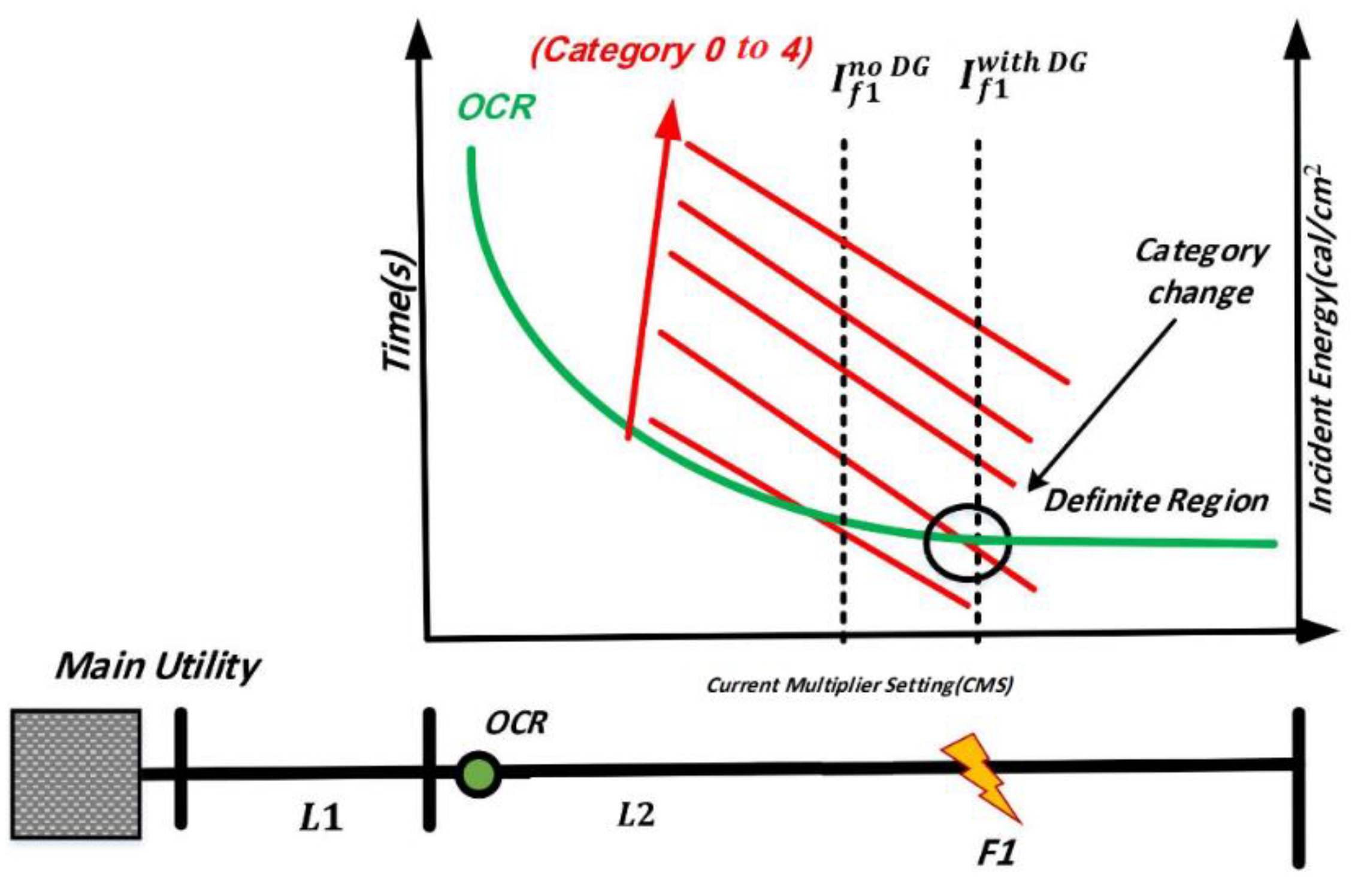
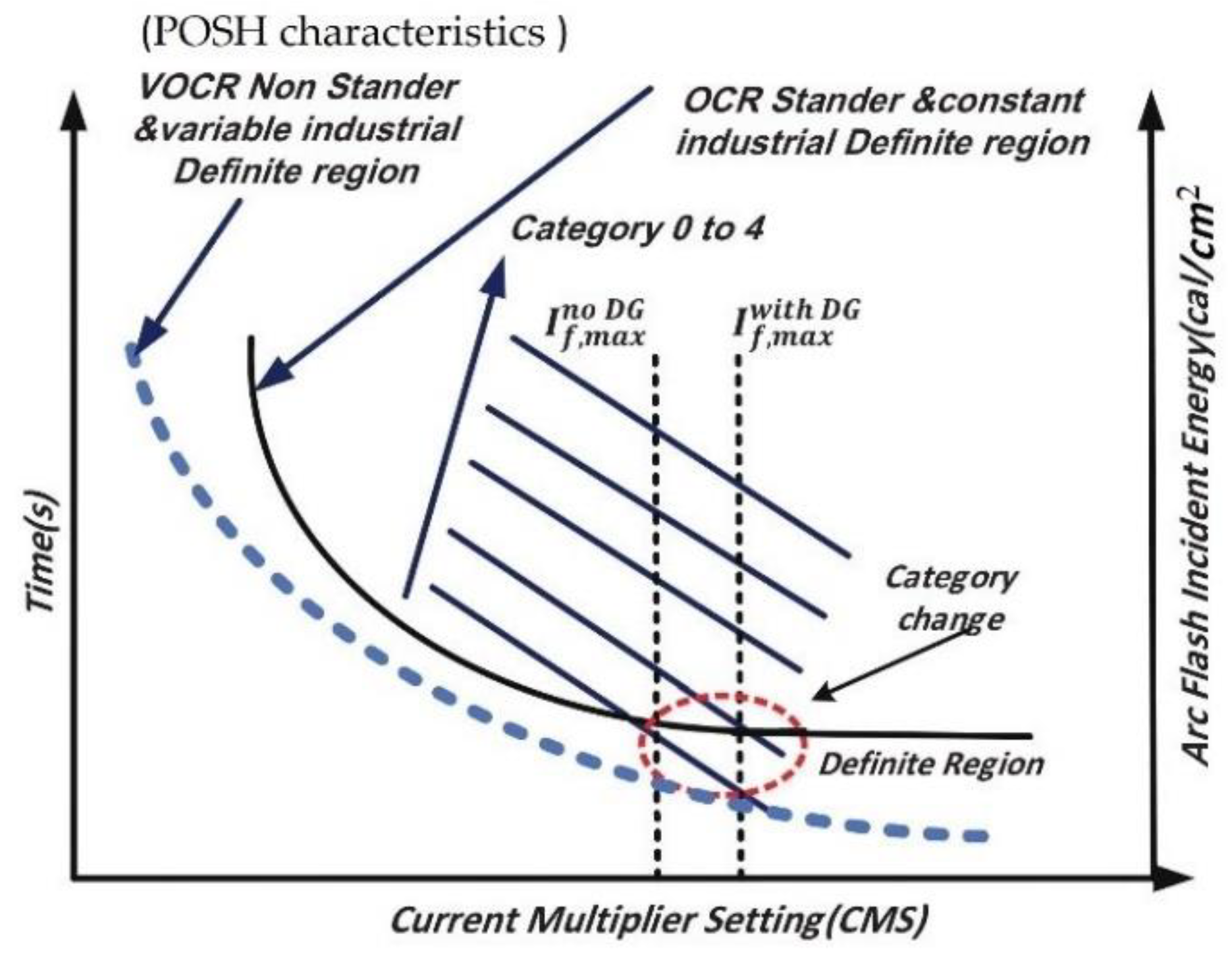
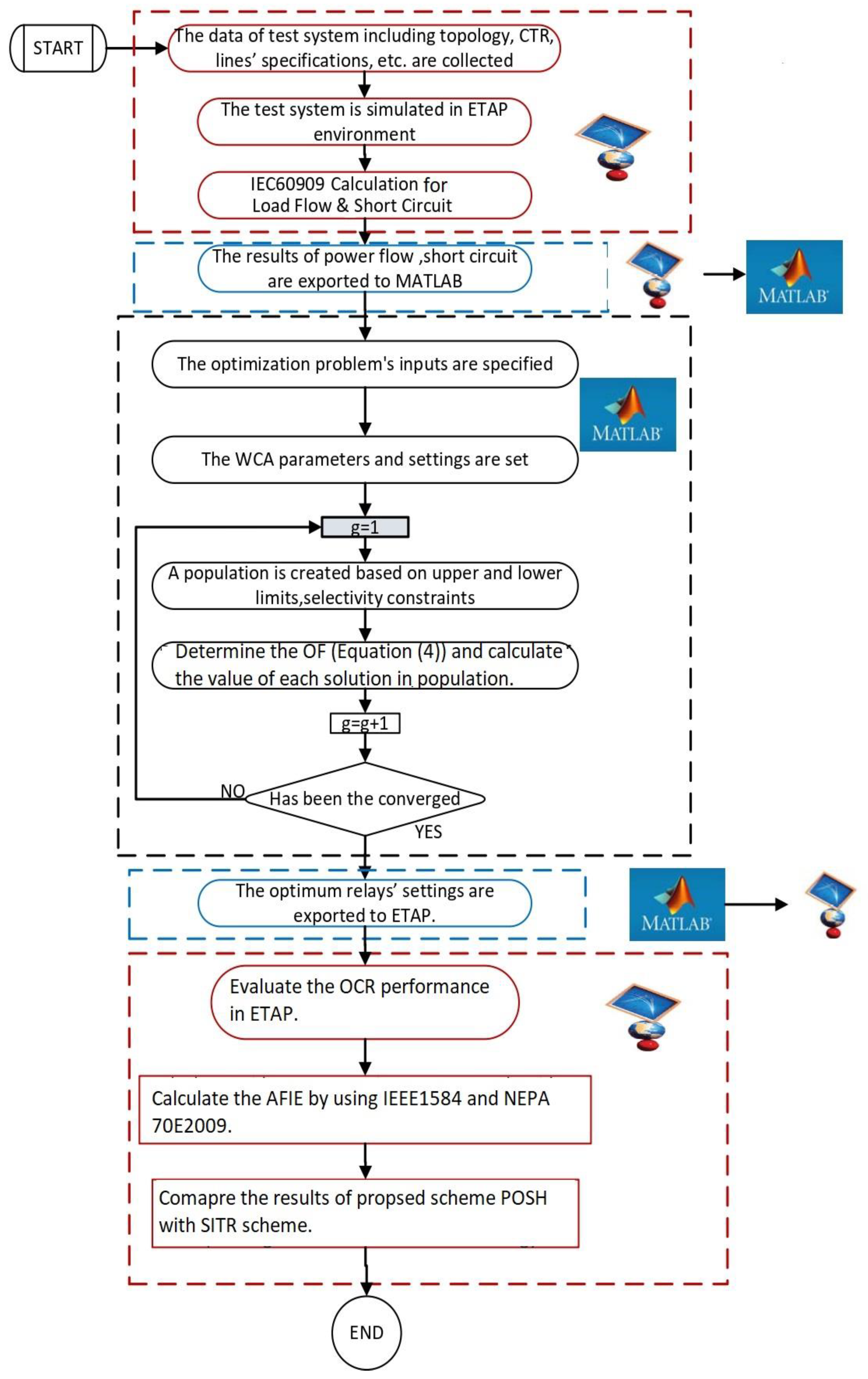
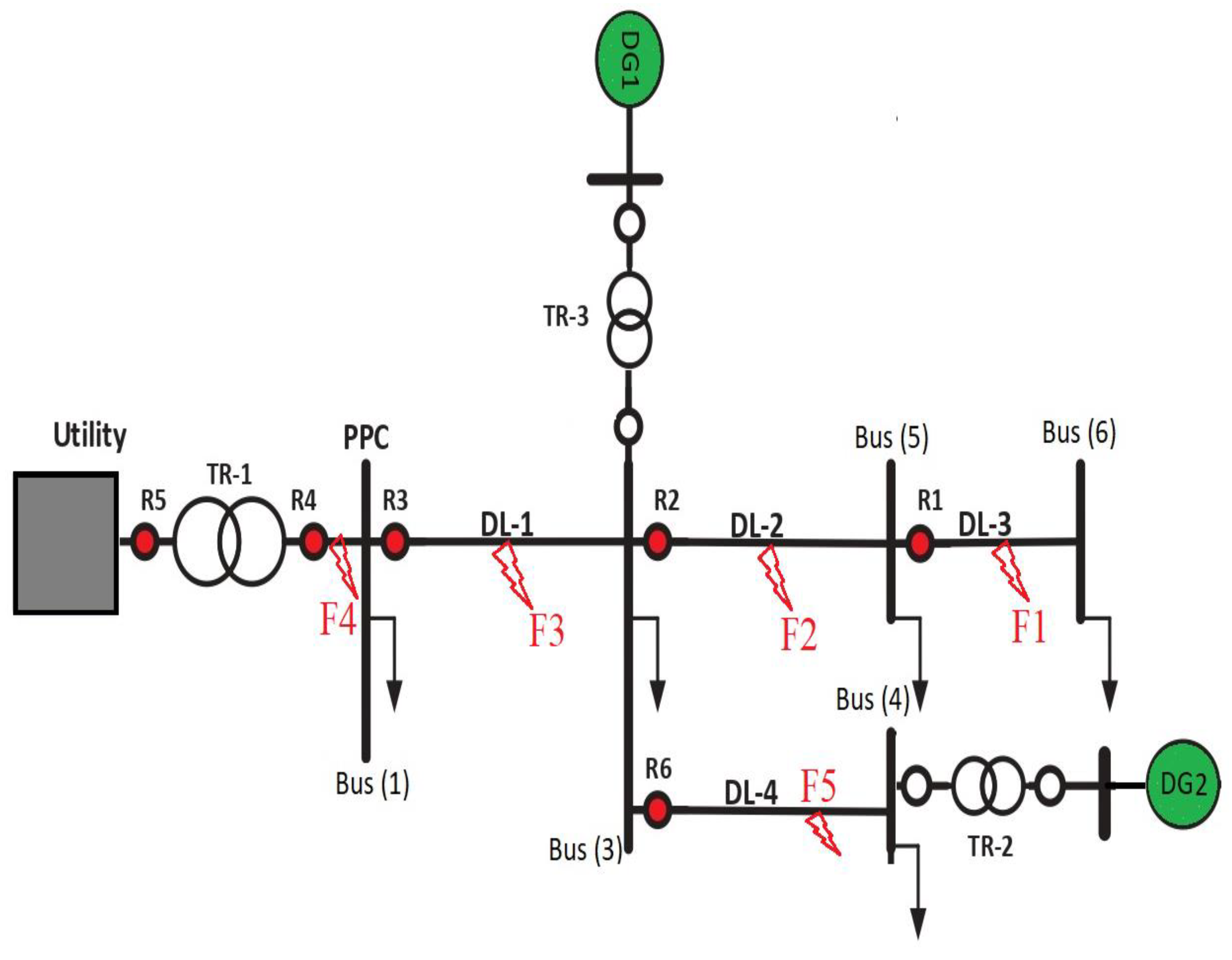

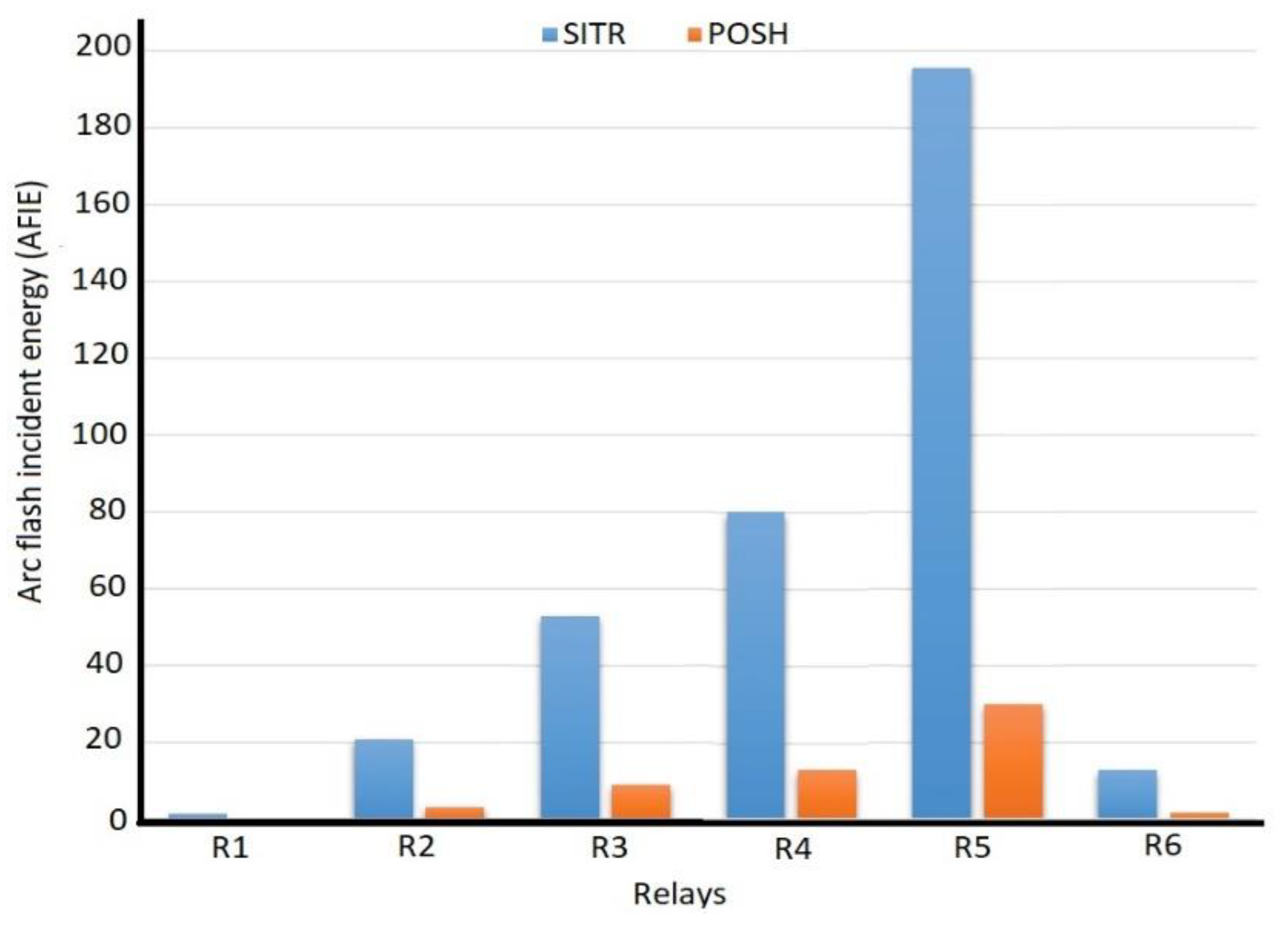
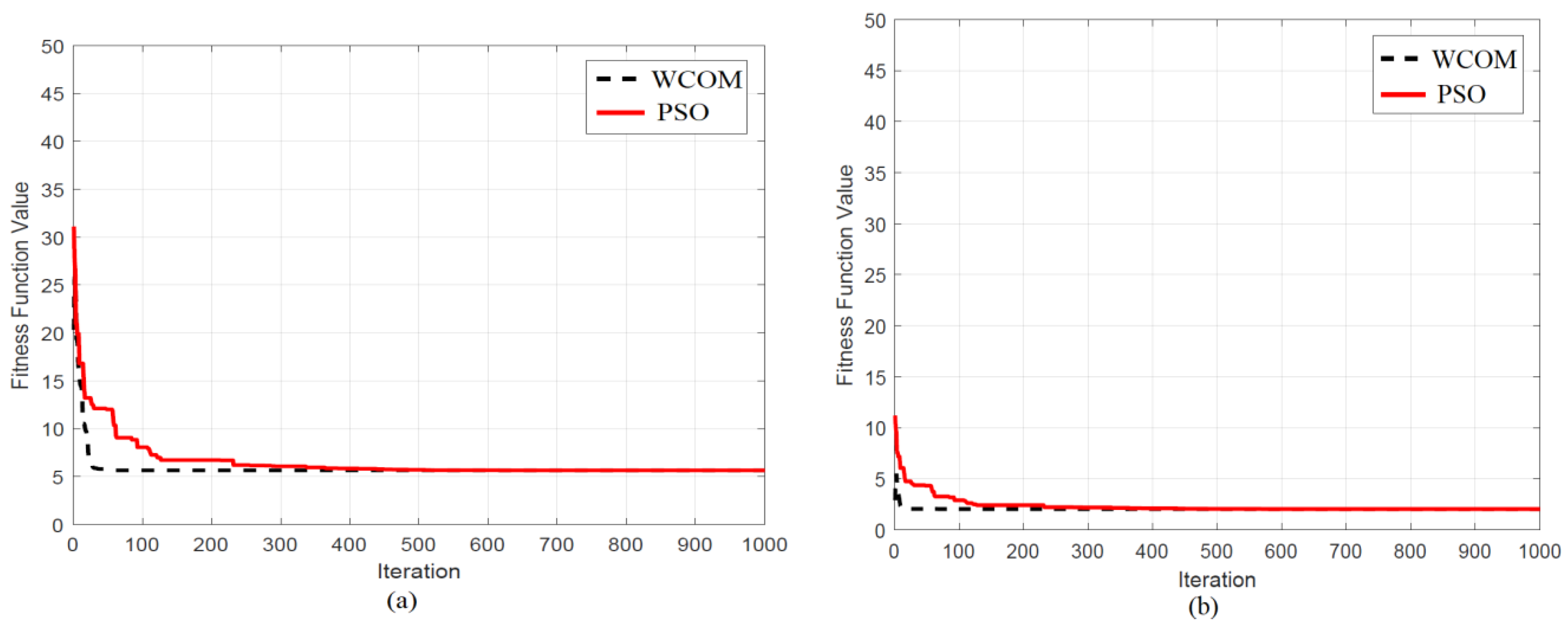
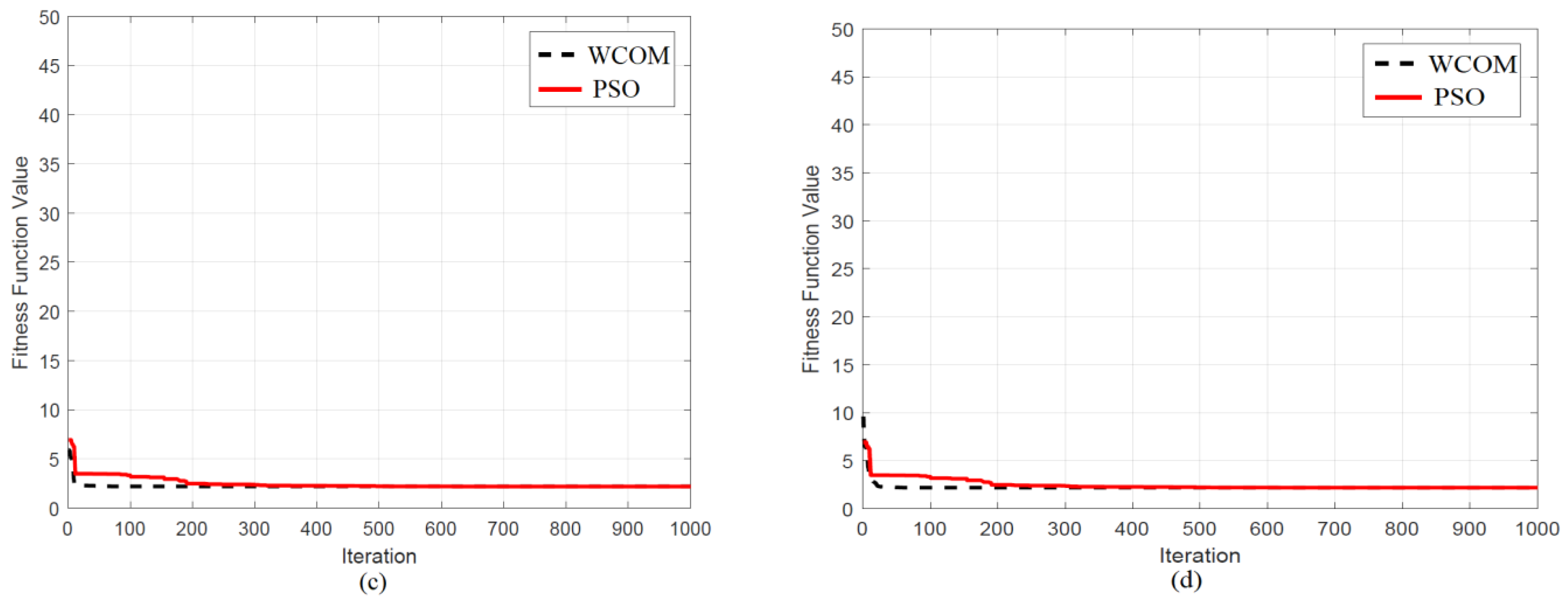
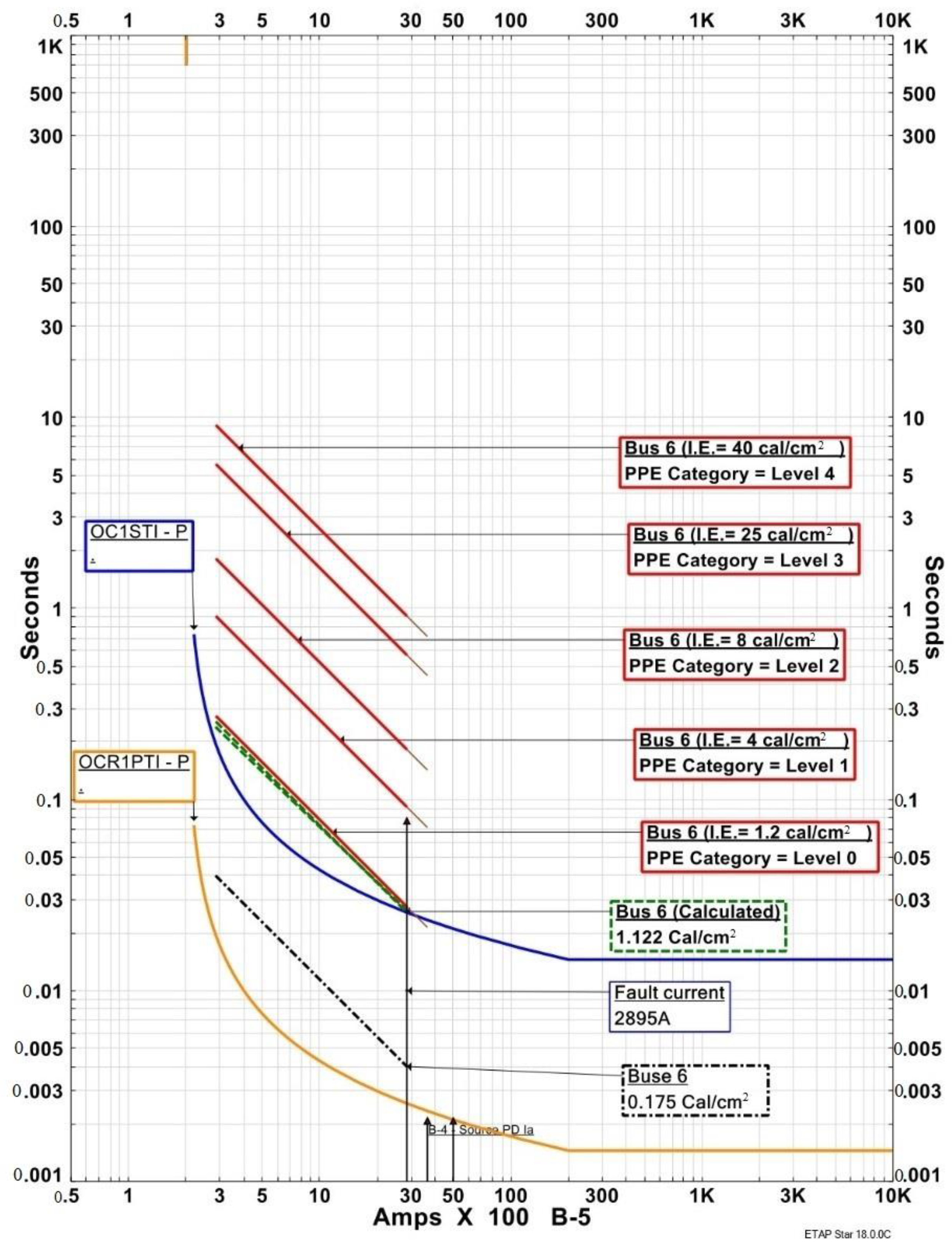
| Parameters | Value |
|---|---|
| The maximum number of Iteration | 1000 |
| Number of populations | 50 |
| The constant of evaporation condition | |
| Number of stream and sea | 4 |
| Relay | CTR | PS | IPP (A) |
|---|---|---|---|
| R1 | 400/1 | 0.5 | 200 |
| R2 | 400/1 | 0.5 | 200 |
| R3 | 400/1 | 0.5 | 200 |
| R4 | 1200/1 | 0.96 | 1152 |
| R5 | 300/1 | 0.83 | 249 |
| R6 | 400/1 | 0.35 | 140 |
| Fault Location | Fault Current (A) | CT | PS | CMS | Relay |
|---|---|---|---|---|---|
| F1 | 4550 | 400/1 | 0.5 | 22.75 | R1 |
| F1 | 4550 | 400/1 | 0.5 | 22.75 | R2 |
| F2 | 5130 | 400/1 | 0.5 | 25.65 | R2 |
| F2 | 5130 | 400/1 | 0.5 | 25.65 | R3 |
| F3 | 8380 | 400/1 | 0.5 | 41.9 | R3 |
| F3 | 8380 | 1200/1 | 0.96 | 7.274306 | R4 |
| F4 | 8380 | 1200/1 | 0.96 | 7.274306 | R4 |
| F4 | 1790 | 300/1 | 0.83 | 7.188755 | R5 |
| F5 | 5130 | 400/1 | 0.5 | 25.65 | R6 |
| F5 | 5130 | 400/1 | 0.5 | 25.65 | R3 |
| Fault Location | Fault Current (A) | CT | PS | CMS | Relay |
|---|---|---|---|---|---|
| F1 | 2890 | 400/1 | 0.5 | 14.45 | R1 |
| F1 | 2890 | 400/1 | 0.5 | 14.45 | R2 |
| F2 | 3695 | 400/1 | 0.5 | 18.475 | R2 |
| F2 | 3695 | 400/1 | 0.5 | 18.475 | R3 |
| F3 | 5130 | 400/1 | 0.5 | 25.65 | R3 |
| F3 | 5130 | 1200/1 | 0.96 | 4.453125 | R4 |
| F4 | 8380 | 1200/1 | 0.96 | 7.274306 | R4 |
| F4 | 8380 | 300/1 | 0.83 | 33.65462 | R5 |
| F5 | 3695 | 400/1 | 0.5 | 18.475 | R6 |
| F5 | 3695 | 400/1 | 0.5 | 18.475 | R3 |
| Relay | Mode 1 | Mode 2 | ||
|---|---|---|---|---|
| SITR (TMS) | POSH (TMS) | SITR (TMS) | POSH (TMS) | |
| R1 | 0.01 | 0.01 | 0.01 | 0.01 |
| R2 | 0.127 | 0.145 | 0.147 | 0.153 |
| R3 | 0.2562 | 0.185 | 0.292 | 0.199 |
| R4 | 0.1805 | 0.09 | 0.239 | 0.096 |
| R5 | 0.4801 | 0.22 | 0.326 | 0.223 |
| R6 | 0.3846 | 1.706 | 0.436 | 1.85 |
| OOT | 5.68 | 2.565 | 6.1 | 2.613 |
| Relay | SITR | POSH | ||||||
|---|---|---|---|---|---|---|---|---|
| FCT | AFIE | AFB | EL | FCT | AFIE | AFB | EL | |
| R1 | 0.023 | 1.312 | 3.14 | 1 | 0.03 | 0.168 | 1.12 | 0 |
| R2 | 0.266 | 20.75 | 12.5 | 3 | 0.04 | 3.123 | 4.84 | 1 |
| R3 | 0.462 | 52.79 | 21.12 | 4 | 0.07 | 8.97 | 8.22 | 3 |
| R4 | 0.623 | 79.86 | 24.52 | 4 | 0.1 | 12.826 | 9.86 | 3 |
| R5 | 1.17 | 195.5 | 51.15 | 4 | 1.18 | 29.99 | 20.03 | 4 |
| R6 | 0.163 | 12.74 | 9.79 | 3 | 0.02 | 1.56 | 3.42 | 1 |
| Relay | SITR | POSH | ||||||
|---|---|---|---|---|---|---|---|---|
| FCT | AFIE | AFB | EL | FCT | AFIE | AFB | EL | |
| R1 | 0.022 | 1.5 | 3.36 | 1 | 0.03 | 0.207 | 1.249 | 0 |
| R2 | 0.28 | 37.19 | 16.73 | 4 | 0.423 | 0.423 | 1.785 | 0 |
| R3 | 0.527 | 80.39 | 24.6 | 4 | 15.25 | 15.25 | 10.71 | 3 |
| R4 | 0.827 | 126.08 | 30.81 | 4 | 20.74 | 20.74 | 12.49 | 3 |
| R5 | 1.14 | 203.68 | 52.2 | 4 | 31.9 | 31.9 | 20.66 | 4 |
| R6 | 0.28 | 37.19 | 16.73 | 4 | 0.423 | 0.423 | 1.785 | 0 |
| Relay | Mode 1 | Mode 2 | ||||||
|---|---|---|---|---|---|---|---|---|
| SITR (TMS) | POSH (TMS) | SITR (TMS) | POSH (TMS) | |||||
| WCOM | PSO | WCOM | PSO | WCOM | PSO | WCOM | PSO | |
| R1 | 0.01 | 0.01 | 0.01 | 0.01 | 0.01 | 0.01 | 0.01 | 0.01 |
| R2 | 0.127 | 0.128 | 0.145 | 0.147 | 0.147 | 0.148 | 0.153 | 0.155 |
| R3 | 0.2562 | 0.262 | 0.185 | 0.19 | 0.292 | 0.295 | 0.199 | 0.2 |
| R4 | 0.1805 | 0.181 | 0.09 | 0.09 | 0.239 | 0.240 | 0.096 | 0.099 |
| R5 | 0.4801 | 0.485 | 0.22 | 0.225 | 0.326 | 0.33 | 0.223 | 0.23 |
| R6 | 0.3846 | 0.386 | 1.706 | 1.7 | 0.436 | 0.44 | 1.85 | 1.9 |
| OOT (s) | 5.68 | 5.74 | 2.565 | 2.66 | 6.1 | 6.21 | 2.613 | 2.7 |
| Elapsed time (s) | 4.37 | 7.39 | 4.44 | 5.42 | 4.22 | 5.33 | 4.22 | 5.77 |
Publisher’s Note: MDPI stays neutral with regard to jurisdictional claims in published maps and institutional affiliations. |
© 2021 by the authors. Licensee MDPI, Basel, Switzerland. This article is an open access article distributed under the terms and conditions of the Creative Commons Attribution (CC BY) license (https://creativecommons.org/licenses/by/4.0/).
Share and Cite
Alasali, F.; Saad, S.M.; El-Naily, N.; Layas, A.; Elhaffar, A.; Hussein, T.; Mohamed, F.A. Application of Time-Voltage Characteristics in Overcurrent Scheme to Reduce Arc-Flash Incident Energy for Safety and Reliability of Microgrid Protection. Energies 2021, 14, 8074. https://doi.org/10.3390/en14238074
Alasali F, Saad SM, El-Naily N, Layas A, Elhaffar A, Hussein T, Mohamed FA. Application of Time-Voltage Characteristics in Overcurrent Scheme to Reduce Arc-Flash Incident Energy for Safety and Reliability of Microgrid Protection. Energies. 2021; 14(23):8074. https://doi.org/10.3390/en14238074
Chicago/Turabian StyleAlasali, Feras, Saad M. Saad, Naser El-Naily, Anis Layas, Abdelsalam Elhaffar, Tawfiq Hussein, and Faisal A. Mohamed. 2021. "Application of Time-Voltage Characteristics in Overcurrent Scheme to Reduce Arc-Flash Incident Energy for Safety and Reliability of Microgrid Protection" Energies 14, no. 23: 8074. https://doi.org/10.3390/en14238074
APA StyleAlasali, F., Saad, S. M., El-Naily, N., Layas, A., Elhaffar, A., Hussein, T., & Mohamed, F. A. (2021). Application of Time-Voltage Characteristics in Overcurrent Scheme to Reduce Arc-Flash Incident Energy for Safety and Reliability of Microgrid Protection. Energies, 14(23), 8074. https://doi.org/10.3390/en14238074






